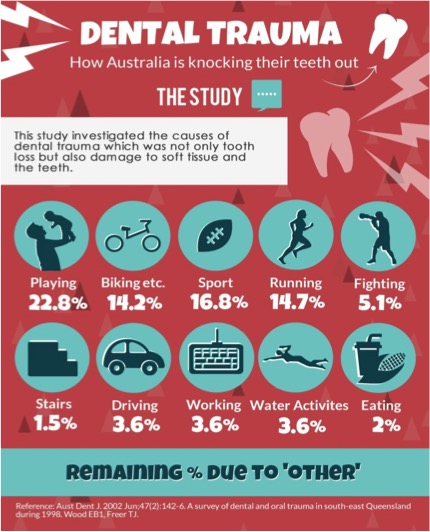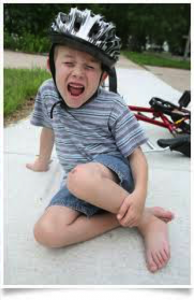Dental Trauma
 Unfortunately we can’t prevent children from having accidents, but we can manage dental trauma that occurs.
Unfortunately we can’t prevent children from having accidents, but we can manage dental trauma that occurs.
Approximately 30% of children have experienced injuries to the mouth. However these sort of injuries don’t only happen to children.
The cause of dental traumatic injuries varies considerably. While sports continue to be the main cause of dental trauma, leisure activities are also becoming increasingly associated with trauma.
Activities such as roller-blading, skate boarding, mountain bike riding, trampolining and horse riding are now significantly associated with dental trauma.
Toddlers can also encounter many bumps and falls when first learning to walk.
An accident involving the teeth in serious cases affects aesthetics or appearance. Injuries to the mouth include teeth that are knocked out, fractured, forced out of position, pushed up or loosened. Root fractures and dental bone fracture can also occur.
Dental Avulsion (Knocked out tooth)
- Avulsion occurs when a tooth is completely displaced out of the dental socket. If it is a primary or baby tooth usually this tooth is not reimplanted.
- If the tooth is clean, place it straight back in its socket.
- If it is dirty, wash it in milk — if milk is not available, use water but only for a few seconds.
- Do not scrub the root surface and try not to touch the root.
- Having removed any debris, now try to replace the tooth in its socket.
- If you can’t replace it, wrap the tooth in plastic wrap or store it in milk. Most importantly, get to a dentist immediately, with the tooth. The tooth needs to be properly re-implanted and splinted within 30 minutes to have a good chance of long term success.
Tooth Displacement
This involves displacement of the tooth within the socket or partially removed from the socket.
As a first aid place a cold wet cloth over the mouth and get to a dentist as soon as possible. If there is any swelling keep an ice pack over the lip and mouth.
Tooth Fracture
Fracture of the teeth can occur in different levels affecting the crown or root portion of the tooth.
When this happens, rinse with warm water. Use a cold cloth or ice pack to reduce the swelling and see a dentist as soon as possible.
Intrusion (tooth pushed up)
In this case the tooth can be impacted into the bone causing damage to the surrounding structure. If a primary tooth is intruded it may damage the developing permanent tooth.
Rinse with cold water, keep an ice pack to reduce swelling and see a dentist as soon as possible.
Dental concussion (tooth is hit)
 This results in mild injury to the supporting structure of the tooth. Tooth can be mobile and usually have bleeding.
This results in mild injury to the supporting structure of the tooth. Tooth can be mobile and usually have bleeding.
Tooth may change colour because it affects the blood supply to the tooth.
Rinse with cold water, keep an ice pack over the lip and mouth to reduce swelling, and see a dentist.
In all these incidents the trauma to a tooth can cause nerve damage and may require treatment of the nerve which is called root canal therapy. The nerve can die some time, even years after the traumatic incident.
Not only do the injuries and their treatments vary, but they are also influenced by the type of tooth whether deciduous (primary or baby) teeth or permanent (adult) teeth, as well as their stage of growth and development.
All of the above can be prevented to an extent by using a custom fit mouthguard made by your dentist. Over the counter mouthguards don’t fit well so do not provide an adequate level of protection and are not as comfortable as custom fit mouthguards.
Mouthguards not only protect the teeth and soft tissue, they also help prevent lacerations and bruising of the lips and cheeks as well as concussion.
Where there is an option of preventing injury to your teeth with a mouthguard, why hesitate?
For more information contact Vision Dental on (02) 9543 4222.
